
Official Edgar Rice Burroughs Tribute Site Since 1996 ~ Over 15,000 Webpages in Archive Presents Volume 1493 PUZZLES OF AMTOR, SPECIES TRANSFER BETWEEN WORLDS by Den Valdron
|

Official Edgar Rice Burroughs Tribute Site Since 1996 ~ Over 15,000 Webpages in Archive Presents Volume 1493 PUZZLES OF AMTOR, SPECIES TRANSFER BETWEEN WORLDS by Den Valdron
|
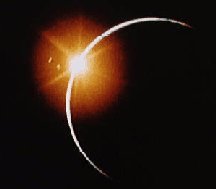
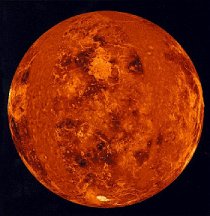
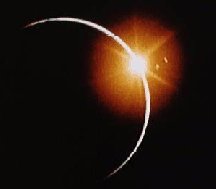
There are human races in Pellucidar, on the Moon, Mars, Venus, Pellucidar, Jupiter and the Poloda system who appear physically and even genetically identical to human. There are, of course minor variations in colour and ethnicity from world to world, but the degree of resemblance exceeds all reason. Even the most aberrant race, the Barsoomians, who are immensely long lived, egg laying, capable of being frozen solid and reviving and capable of regenerating neural tissue appear kin to the human to the point of having the same standards of beauty, sexual characteristics, mating behaviours and are even, impossibly enough, cross fertile. We've discussed this elsewhere, but it seems apparent that the only feasible explanation for the continuing encounters with clearly human races, is that all humans must be derived from a single population. All humans through the solar system and Poloda are ultimately the same species, homo sapiens, originating on Earth. Of course, there are genuinely non-human species. The Solar System is full of non-human but arguably intelligent species, the Kaldanes, Green Men and White Apes of Barsoom, the Va-gas of the Moon, the Brokols and Yooyagan of Venus, the Don of Earth and Pellucidar and the Mahar and Horrib of Pellucidar. None of these other races appear beyond their home worlds, even in mutated or modified form. Based on this, in a paper titled “Are Martians Human?” I developed a theory that humans had spread through the Solar System employing a form of Astral Teleportation. I noted that given the isolation of non-human races, this faculty of Astral Teleportation appeared to be restricted to humans. However, Venus poses us a series of problems which may challenge this assumption. Specifically, there are a number of cases, of varying strength, of non-human creatures of Amtor who may be related to non-human creatures of Earth, Mars and even Jupiter. The first case, and perhaps the most easily dealt with, are the Nobargans. Arguably, there may be an affiliation between the primitive Ape-Men and Saggoth’s of Pellucidar, the Mangani of the surface and the Nobargan of Venus. They may all represent primitive forms of human. But even so, they’re all clearly of the human line. The routes of transmission between Earth and Pellucidar are well known across many species, thus the notion that pre-humans from Earth may have made it into Pellucidar is hardly controversial. On the other hand, pre-humans from Earth making it to Venus? That does seem peculiar and controversial. Yet the Nobargans seem clearly of the hominid line, they use language, they use tools, wield fire, have slings, primitive bows and arrows, live in villages. Their features are described as ape-like. They're well established in both the northern and southern hemispheres of Venus and appear to be relatively common. They seem to be some form of primitive hominid ancestor, though arguably, it is equally possible that they may be some form of regressed human. However, it is entirely possible that the Nobargans may have had the same faculty for astral teleportation that the later true humans most definitely possess. Were the original humanoid colonists of the solar system ape men? It is possible. If so, they are clearly extinct on Mars and the Moon, both worlds having undergone recent mass extinctions and both mainly constituted of habitats which would not be conducive to ape-men. Thuria is likely too small for an ape-man population to survive competition with smarter races. Jupiter and Poloda are unknown. But Venus with its teeming jungles seems a tailor made refuge for the survival of living fossils. On the other side of the evolutionary scale, there is a hint of kinship between the Cloud Men of Venus and the Skeleton Men of Jupiter. Both are races of tall, emaciated beings with pale or parchment like skin. On the other hand, the resemblances are not especially close, and both clearly seem to be derived from human stock. So it is at least as likely that they each arose independently from the human populations of their worlds, as it is that they might be directly related. The matter is particularly complicated here because the Morgor of Jupiter have space travel and so there is a third possibility. At the end of the day, we probably don't have to worry too much about either the Cloud Men or the Nobargans. We may not be sure where they fit or how, but clearly they’re somewhere on the human family tree, and the evidence would reasonably seem to allow for them to either be indigenous to their worlds, or to partake of the faculty of astral teleportation without doing too much violence to our theory of human transmission. There is another area of correspondence. There are Plant men on both Mars and Venus. Both worlds sport ambulatory, roughly humanoid plants, which in itself is a remarkable coincidence. On the other hand, this is most likely a genuine coincidence, for apart from being ambulatory and humanoid, there is little resemblance. The plant man of Barsoom is a non-intelligent creature, a simple predator it stands ten to twelve feet, its short arms are sinuous like an elephant's trunk, and its mouths are at the end of its arm. Its face is a single eye, a ragged hole of a nose and wriggling tendrils thick as earthworms that pass for hair. It sports a thick tail six feet in length, and huge fat, broad feet of about three feet in length. The Brokols, on the other hand are human appearing in every visible respect, except for their green skins, and sporting white sap instead of blood. They are intelligent and civilized. Though they do consume the blood of mammals. The Brokol reproduce from seeds or small nut like eggs, which are planted in the ground by females. After a number of years, the young are born hanging like fruit from the resulting tree. Meanwhile, Plant Men reproduce by buds from their armpits which develop into miniature plant men who eventually fall away from their parents. In short, there seems little correspondence between the Plant Men of Mars and Venus. The botanical history of Barsoom and Thuria (which may be a Barsoomian colony), includes various sorts of mobile and carnivorous plants, which are still extant. So we can reasonably assume an evolutionary history which explains the Barsoomian Plant Man. With Venus, we're presented with no other specimens of mobile or carnivorous plants. But nevertheless, Venus sports a rich profusion of plant life which includes such astonishing specimens as 5000 foot trees. So we can't rule out the possibility of such mobile carnivorous plants on Venus, nor the independent evolution of such plants into the Brokol The big mystery of the Brokol is the degree of identity that the Brokol have with humans. Apart from their skin colour, they are literally physically and mentally indistinguishable, even to the point of speaking the same language, having the same social organization of families, tribes and city state. Why do they look human? There are a couple of possibilities, one of which I'll discuss later. It's possible that the Brokol look human for the same reason that the Lu do. Protective mimicry. Humans are the dominant and most dangerous species, the Brokol have quickly adapted to resemble humans to avoid conflict. In that case, shame about the green skin. Of course, there may be more to it, the Brokol may have pursued human-like adaptations and appearance because they were improvements on their own form. Humans may have represented a series of refinements that guided their own process of self-evolution. Claws or paws to hands, or crude hands to graceful extremities with opposable thumbs, sight refined by binocular vision, etc. Human facial features and other non-essential adaptations pursued without distinguishing them, or being able to distinguish them from essential adaptations. It is interesting to speculate how long this has been going on. Consider the name Brokol, and how phonetically similar it is to Brooklyn, the home of Betty Calwell. What was Calwell's influence and role for the Brokol? Was she a template that they refined their species around? But now we come to the really tough parts: Carson in his wanderings on Venus, runs across two races which have eerie resemblances to a pair of very peculiar races found on Earth. We speak, of course, of the inhabitants of Caspak, the Wieroo and Lu peoples and of the Angan and Myposans of Venus. Now the trouble here is that these creatures are quite clearly not from the human line. The skeletal features of the Wieroo and Angan, and the reproduction of the Lu and Myposans definitely exclude them from any place on the hominid family tree. Arguably, none are even placental mammals. You'd have to go back seventy million or two hundred million years to reach a common ancestor. The Lu of Caprona, although they seem human in their final forms, are apparently a human-mimicking species of Amphibian. Their children are not born in the normal sense, and their communities have no babies or young. Instead, females lay massive quantities of eggs in warm pools, which flow through Caprona's river system. The eggs hatch as fish, transform to amphibians, become apes and progress steadily up the evolutionary ladder until finally achieving apparent humanity. Their behaviour is heavily influenced by instinct. In a separate discussion, I have argued that the Lu likely evolved from frogs, becoming first giant biped amphibians, and then adapting to copy humans when humans became the dominant species in Pellucidar. On Venus we have the Myposans, who are a peculiar amphibian race. They resemble bearded men with gills, full lips and bulging eyes. In short, they are more obviously amphibian than the Lu. Like the Lu, their eggs are laid in the water, developing first as fish, then as amphibians, finally losing their tails and becoming small children. In short, the overall shape of the Myposan life cycle is essentially that of the Lu. Of course, there are many differences. The Lu cautiously pass up through a series of increasingly complex stages from apparent ape to apparent true human. The Myposans appear to graduate instead to something apparently human. The Lu have no apparent interest in their offspring, the Myposans shelter their offspring in special pools, protect them from predators, and celebrate their ascension from amphibian/salamander status to childlike state. The Lu are instinct driven, the Myposans appear pompous but not very bright. The Lu appear physically identical to human, the Myposans retain gills. But despite this the two races are united in being peculiarly near indistinguishable from human, of human intelligence and technical capacity, and yet being fundamentally amphibian. Their amphibian natures suggest that they have more in common with each other, than either has with the true humans of their respective worlds. As a workable theory, it appears that the humans of the various worlds are indeed not separately occurring species, but actually the same species, with local variation, appearing on world after world. So, we have to acknowledge that if this is so, then it seems possible that the amphibian/humans of Venus and Caprona may be genuinely related. Otherwise it seems remarkable that two independent lines of amphibians would both produce races so very nearly human. You'll recall that independent lines of mobile plants did not produce effectively nearly identical creatures on Mars and Venus, and only one of those lines resulted in something nearly human. Two independent planetary lines of amphibian evolution separately producing human races seems a little much. There is a second peculiar parallel, between the Angan and the Wieroo. With both, we have winged humanoids with free legs and arms, essentially, instead of the four limb plan common to terrestrial animals, these creatures have six (four limbs plus two wings). This ‘six limb’ function is shared by only one other creature on Earth, the Trodon of Pellucidar. On the other hand, life on Venus may be more flexible. While most animals described by Carson on Venus are clearly four legged, a few seem to have extra appendages. The first predator that Carson meets, for example, is four legged, but possessed of two crablike chelae in front of its forelimbs which it uses to seize prey and drag them towards it. But still, the six limb design seems rare on Venus and unknown to other hominids. I've argued that the Wieroo wings are actually adapted ribs, and that the Weiroo's true ancestry is no more recent than Australian marsupials, or perhaps Lu like amphibians, or even Draco lizards. The likelihood of the Wieroo evolving from the human line is vanishingly small. So too with the Angan, while its possible that their wings may be real limbs, instead of adapted ribs, this development is not found at all in hominids on Venus, and seems extremely rare. Even with other ‘six limb’ animals, the two extra ‘limbs’ appear only partially developed. In the predator that Carson encounters initially, the front ‘limbs’ do not appear to be fully articulated limbs but merely chelae which end, not in articulated paws or hands, but crude crablike grasping claws. It seems impossible that the Angan wings have sprung from hominid lines. Their evolution and evolutionary forbears must be radically different. Indeed, all other factors being equal, it seems likely that the evolutionary paths which would lead to Angan and Wieroo must be effectively identical. Which in turn, suggests that the pathway is the same for both, and that they are related species springing from a common ancestry. Once again, of course, there are numerous small differences. The Wieroo have large almost google eyes. The Angan eyes are beady and close set. The Wieroo are hairless and bald, the Angan are adorned with feathers at head and crotch. The Wieroo of Caprona are tail-less, the Angan's have feathered tails that spread out like a fan. More significantly, the Wieroo's limbs have normal proportions and plump feet, the Angan have long arms and short legs ending in talons. Oddly, the apocryphal Wieroo of Pal Ul Don have similar peacock tails and feathers, and prehensile feet with talons. The Wieroo seem more intelligent than the Angan, who in turn, seem more intelligent than the apocryphal Wieroo of Pal Ul Don. On the other hand, the Caprona Wieroo thought and behaviour is peculiar, based entirely on dominance with no sense of community or loyalty. Several observers comment on the peculiar and basic psychology of the Angan, creatures with no real community or loyalty, content to serve whoever is dominant at the moment. So there may be some psychological correspondence between Wieroo and Angan. One item which might have been interesting was sexual. The Wieroo are apparently exclusively male, and use other creatures to breed apparently male Wieroo offspring. The Angan? We are offered no glimpse of Angan society, the only individuals we meet are apparently male. There is too little here to amount to more than a tantalizing speculation. Clearly the Wieroo and Angan are distinct races, with
respect to fine details there are no shortage of differences, but nevertheless,
their similarities to each other seem greater than that between Earth Human
and Mangani, whose relationship is acknowledged. Both seem
profoundly distinct from the human races of their respective worlds.
But once again, if we concede the possibility that the human populations of the Solar System are essentially the same species somehow transported from star to star, then we must acknowledge the possibility that Lu/Myposans and Wieroo/Angan are also actually populations of the same root species existing on two worlds. But of course, that poses its own problems. How do they get there? There is certainly no evidence to support any notion of a Wieroo or Lu civilization advanced enough to travel between worlds on its own. Had there been, the ‘footprint’ of such a civilization, even lost, would have been huge. Instead, both the Wieroo and Lu seem to have been minor evolutionary curiosities of limited importance. Nor does the notion of a friendly alien or human race giving the Wieroo and Lu a lift seem to be available. Burroughs world simply has no evidence of such a race. So perhaps the Lu and Wieroo independently evolved astral teleportation? Perhaps it's a faculty common to all intelligent races? Well, if its common to all intelligent races, why isn't the solar system overrun with Horribs, Mahars and Green Men on every world? But if its merely restricted to Humans, Lu and Wieroo, then why are humans on ever world, but the Lu and Wieroo confined merely to Earth and Venus? Perhaps there was some feature of Caprona that facilitated the Lu and Wieroo passage to Venus, but if that's the case, why didn't any of the other Caprona wildlife also make the transition? There don't seem to be clear answers, only a series of possibilities which themselves raise questions. But there are a couple of additional hypothesis which we can offer up to explain the presence of beings so like the Lu and Wieroo on Venus. First, it is possible even likely, that all of the other intelligent races out in the solar system may be instances of human astral teleportation gone wrong. I've discussed elsewhere how there appears to be some degree of adaptation which allows John Carter to acclimate easily to Martian conditions, rather than choking on pollen and dust, gasping for breath in air too thin, sickening from microbes in water or vomiting from alien food. The self evident fact of Carter having been ‘adapted’ may be in his obvious cross fertility with an egg laying woman. Adaptation, as noted, involves degrees. It's likely that some astral teleportations were so little adapted to their new worlds they immediately expired. And its likely that some astral teleportations were so radically altered that they ceased to be truly human. Perhaps they incorporated alien DNA, mutating into Green Men and Great Apes. Perhaps they incorporated DNA found in their clothing or their stomachs, mutating into creatures like the Va-Gas. However, if this is the case, then we must acknowledge that while humans astral teleported from Earth to other worlds, there must have been occasions when humans of other worlds astral teleported to Earth. In fact, both Betty Calwell and John Carter have made return journeys. If this is so, then this allows for the possibility of mutated humans on Earth! So, this may be the origin of the Lu, the Wieroo, the Horrib, the Don and perhaps even the Mahar and Mangani of Earth, as well as the remarkably human Brokol plants and Vooyorgan amoeba of Venus. All of these apparently ancient species may in fact be inadvertent spin offs of human evolution, accidental children of human space travel. Of course, that still leaves an unanswered question: Why the Lu and Wieroo have such similar counterparts in the Angan and Myposan? This theory offers an explanation for literally every intelligent race on every world, including our own. But it doesn't offer an explanation for effectively the same non-human intelligent race on two worlds, much less two such non-human intelligent races. There is a further possibility to be explored, once again, with its own inherent problem. I've suggested that the faculty of astral teleportation may only be a special refinement of a greater planetary attribute. The nature of astral teleportation is that a new body is literally created on another world, from apparently alien matter. In essence, matter or energy is transformed to create a physical form. If this is the case, then how far could such a transformation extend? It seems unlikely that the interior of the moon, the surfaces of Mars and Venus, and even Jupiter, would naturally be hospitable to Earthly human life. In fact, in our world, none of these bodies are hospitable, though potentially some might be eventually terraformed or transformed. The fact that they are hospitable to Earth suggests that the have been ‘transformed’ to be like this. Thus, we speculate that Earth's life possesses a ‘collective spirit’ or ‘collective life energy’ which, from time to time, produces a clone or fragment which leaves Earth for some other world. When it arrives, on the Moon, on Mars or Venus or wherever, this clone or fragment recreates an Earthlike environment and life forms, much as individual astral teleportation recreates a person's physical body. It is imperfect of course, the passage through space, the transformation of matter on an alien world introduces error. New mutations, most of them not viable, arise. Individuals of different species are mixed. Hiccups in the signal produce distortions, extra organs or limbs, whatnot. The new life on the transformed world is different from the life of Earth on gross levels of anatomy (but not on levels of chemistry or molecules). Sometimes, we must assume that conditions on the target world are so inhospitable that the new life and the newly transformed environment fails or begins to fail almost immediately. But if the phenomena is a recurrent one, then sooner or later, a transformation will be stable and permanent. It's just a matter of trying it again and again. Why would this happen? Or when? I can imagine one possible trigger: Mass extinctions. An asteroid hits, a super volcano blows, perhaps a solar eruption emerges, and within a short time, there is a massive die off of life on Earth, including the extinctions of species. If indeed all living things on Earth have some degree of life force, and if Earth's life force has a collective nature, then the catastrophic event of mass extinction would produce a kind of volcanic eruption of that life force, literally ‘blasting’ a massive portion of life force, the accumulated collective death energies of plants and animals on a planetary scale, erupting off the planet. In my discussion of the Moon's live on its inner world, Va-Nah, I speculated that the original ecology of the Moon seemed to be that of fairly primitive reptiles, and resembled the Permian era of Earth. There was a major Permian extinction. Meanwhile, the surviving fauna of Barsoom have a ‘dinosaurian’ quality, so perhaps Mars was a by-blow of a mezosoic extinction, perhaps even ‘the’ mezosoic extinction. The wild life of Venus, in contrast, appears to be distinctly mammalian. There are reptiles of course, all sorts of reptiles and some of them quite large and terrible. But Carson clearly distinguishes the reptiles from other sorts of animals, and these other animals are distinctly mammalian or avian for the most part. What we might infer from this is that the mass extinction which successfully transformed Venus took place during the age of Mammals, either 45 million years ago or 10 million years ago. If this is the case, and Venus transformation does date to this period, then we may well be in the right time frame for the Lu and Wieroos initial evolution. But that doesn't explain why the Lu and Wieroo remained so similar in their new worlds, and other Venerian life diverged so strongly from terrestrial inspiration. But perhaps this is a factor of complexity. The Lu and Wieroo had highly organized nervous systems and sentience, so perhaps these qualities allowed these races, or enough members of these races to form a breeding population, to hold themselves together more than creatures like lions and lizards. It's an imperfect theory, but there you go. Unfortunately, we do not have hard or even comprehensive answers. In the end, we are left with the incontrovertible similarity of races on two worlds, of the Wieroo and Angan, and of the Lu and Myposan, which seems undeniable and which does not admit to any easier explanation than authorial laziness. Based on our previous speculations and analysis of the Burroughs Universe, we offer a series of theories, none completely satisfactory. But there you go. 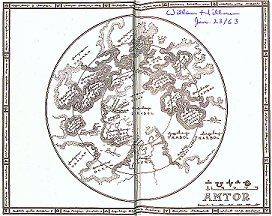
Map of Amtor by ERB |
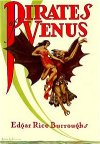
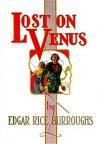
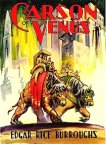
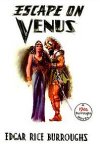
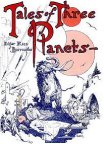

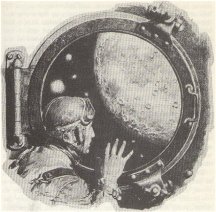
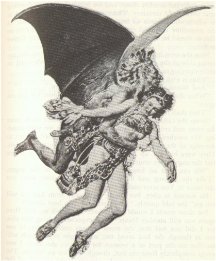
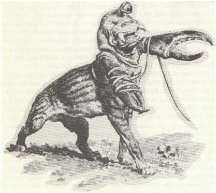
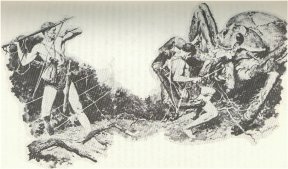
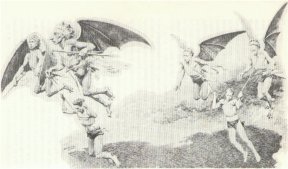
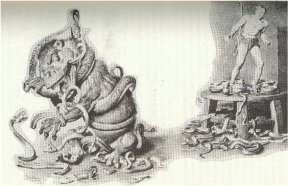
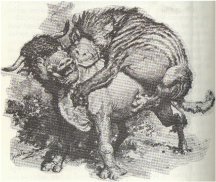
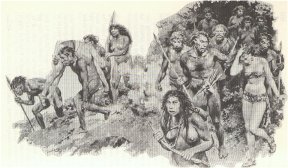
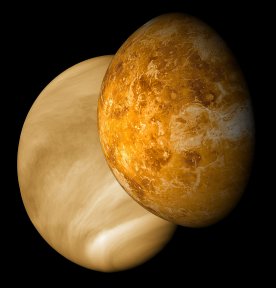
ERBzine WEB REFS
Pirates
of Venus
Lost
On Venus
Carson
of Venus
Escape
On Venus
The
Wizard of Venus
Worlds
of ERB: Amtor
ERB
Artists Encyclopedia
Dejah's
Amtorian Gardens
Amtorian
Art Gallery III: J. Allen St. John
Amtorian
Art Gallery I: Fortunino Matania
Amtorian
Art Gallery II: Fortunino Matania
Carson
Napier Before Venus by F. Ekman
John
Coleman Burroughs Venus Gallery: Carson of Venus
John
Coleman Burroughs Venus Gallery: Escape On Venus
|
for Den Valdron's Fantasy Worlds of ERB |
![]()

![]()
![]()

![]()
BILL
HILLMAN
Visit
our thousands of other sites at:
BILL
AND SUE-ON HILLMAN ECLECTIC STUDIO
ERB
Text, ERB Images and Tarzan® are ©Edgar Rice Burroughs, Inc.-
All Rights Reserved.
All
Original Work ©1996-2010/2018 by Bill Hillman and/or Contributing
Authors/Owners
No
part of this web site may be reproduced without permission from the respective
owners.